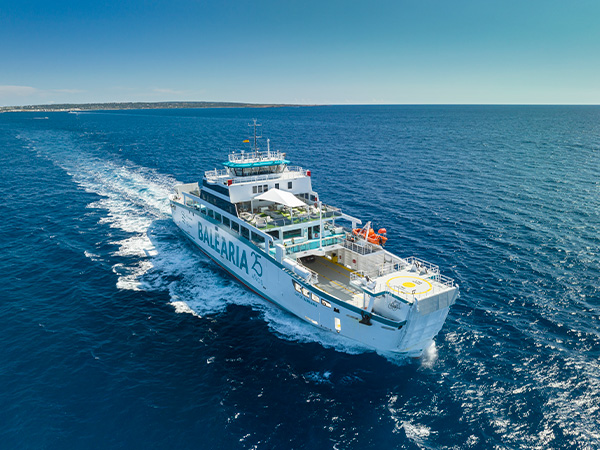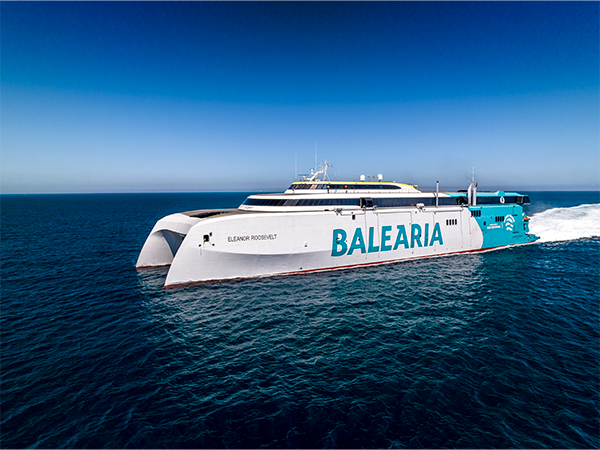EU ETS Legislation (Emissions Trading System)
With the aim of achieving net zero emissions by 2050, the Council of the European Union has approved the application of the EU ETS (Emissions Trading System) directive to the maritime sector as of January 1, 2024. This directive is part of the EU's Fit for 55 plan and aims to accelerate the energy transition of maritime companies towards decarbonization.
The regulations represent a boost both in terms of the construction of more efficient ships and the use of fuels that reduce the environmental impact. A challenge that Baleària has been working on for years, in accordance with its environmental commitment.
Furthermore, the ETS is one of the systems that the EU will use for companies to contribute to joint research and development to eliminate greenhouse gas emissions.
Emissions Market
The EU ETS directive implies that all shipping companies must pay for the number of tons of CO2 emitted by their ships with the aim of progressively limiting these emissions. This new regulation will affect all ships over 5,000 GT and will apply to 100% of CO2 emissions emitted on routes between EU ports and 50% on lines entering or leaving the EU.
This new legislation also contemplates exemptions until the end of 2030 for connections with islands with less than 200,000 inhabitants and outermost regions, such as the Canary Islands. In this sense, the only routes operated by Baleària that would be affected by this regulation until 2030 would be those between the Peninsula and Mallorca, Ceuta and Melilla and the links from Spain and France with Morocco and Algeria.
The entry into force of the EU ETS will have a significant impact on Baleària, since, like the rest of the shipping companies, it will be obliged to acquire emission rights equivalent to the volume of CO2 emitted on non-exempt routes and whose application will be carried out gradual. Thus, during 2024 companies must pay rights for 40% of the total CO2 emitted, 70% in 2025 and up to 100% from 2026.
The emission rights, also known as EUA (European Union Allowance), will be acquired in a competitive market whose price fluctuates daily depending on supply and demand. Likewise, the supply of emission rights will gradually be reduced, so that they will have an increasingly higher cost. The objective is for shipping companies to reduce their environmental footprint.
In addition to all this, Baleària will continue investing in a sustainable fleet and in advancing the use of new, cleaner fuels.
Green Course
Baleària is immersed in the energy transition. As a citizen and responsible company, it takes on the challenge of decarbonization as the only possible path in the fight against climate change. For Baleària, sustainability represents an obligation and an opportunity.
In recent years, Baleària has invested around 500 million euros in a fleet of ten ships with dual gas engines (plus an eleventh under construction), as well as an electric ferry. Dual engines are a versatile technology, since they allow sailing with different fuels, such as natural gas, which the shipping company considers as a transitional energy towards decarbonization and the real and most mature alternative that currently exists in maritime transport to contribute to reduce emissions. Sailing on gas reduces CO2 emissions by up to 30%, NOX emissions by 85% and eliminates 100% of sulfur emissions (SOX) and particles harmful to health. In addition, these dual engines are prepared to consume 100% biomethane or synthetic methane, as well as green hydrogen mixtures of up to 25%, although these renewable energies that are neutral in CO2 emissions are currently unviable due to costs and availability. However, Baleària is already participating in projects linked to biomethane, green hydrogen, synthetic fuels or liquid biogas.
 |  |
On the other hand, Baleària has launched the first electric ferry in Spain, the Cap de Barbaria de Baleària, sailing between Eivissa and Formentera. This electric vessel, when approaching and staying in ports, completely eliminates noise pollution and navigates with zero emissions, which represents a substantial improvement in air quality. The ferry, which has an OPS connection socket, is prepared to be able to install a hydrogen system, since Baleària intends to use the Cap de Barbaria as a test laboratory for the use of hydrogen in the future.
In addition, Baleària has a Fleet Control Tower that allows it to make decisions quickly and efficiently based on the collection and analysis of relevant data in real time. In addition, this Control Tower integrates the data obtained from the measurement and sensor equipment of some ships. Thus, Baleària manages to improve consumption management, reducing unnecessary emissions as much as possible.
FAQ – Directiva EU ETS
What is the ETS (Emissions Trading System)?


The EU ETS is a directive promoted by the European Union within the Fit for 55 program to accelerate the decarbonization of companies by 2050. This initiative, which will come into force from January 1, 2024 in the maritime sector, has the objective to limit the volume of CO2 emissions.
What types of emissions does the ETS regulate?


The EU ETS regulates the amount of tons of CO2 emitted by ships during navigation and in port, known as tank to wake, throughout the year.
What is the scope of the ETS?


This regulation will affect all ships over 5,000 GT (reviewable at the end of 2026). It will apply to 100% of CO2 emissions on trips between EU ports and their stay at the port, and 50% on routes entering or leaving the EU.
How does the ETS work?


Shipping companies will be obliged to acquire emission rights equivalent to the volume of CO2 emitted throughout the year. These rights are acquired in a competitive market whose price fluctuates daily based on supply and demand.
How will the regulations be applied?


The application will be gradual so that the first year (2024) will affect 40% of the shipping company's total emissions, the second (2025) 70%, and from the third year (2026) 100% of the emissions.
How does the ETS affect Baleària routes?


Until the end of 2030, the lines operated by Baleària affected by the EU ETS regulations will be: Barcelona-Alcúdia, Barcelona-Palma, València-Palma, Ceuta and Melilla up to 100%, and in connections with Morocco and Algeria, up to 50%.
This is because the ETS regulations contemplate exemptions until the end of 2030 for journeys to islands with less than 200,000 inhabitants (Menorca, Ibiza and Formentera) and outermost regions such as the Canary Islands. Starting in 2031, the regulations will apply to all routes.
What will be the impact of the entry into force of the ETS for Baleària?


Baleària is studying the impact of the entry into force of the new regulations to try to minimize it.


Do you want to change the departure date?







